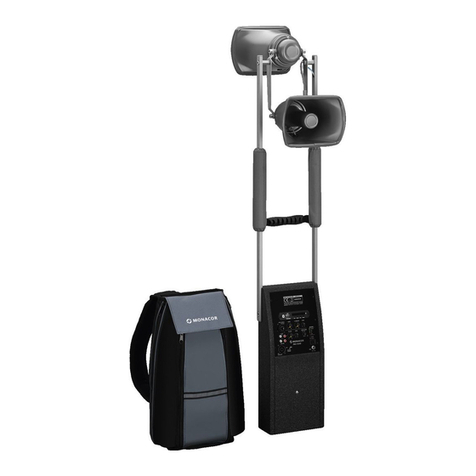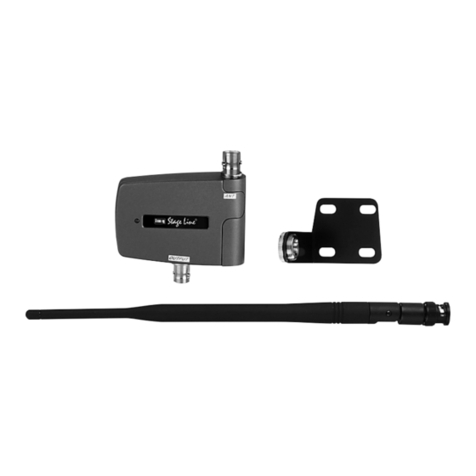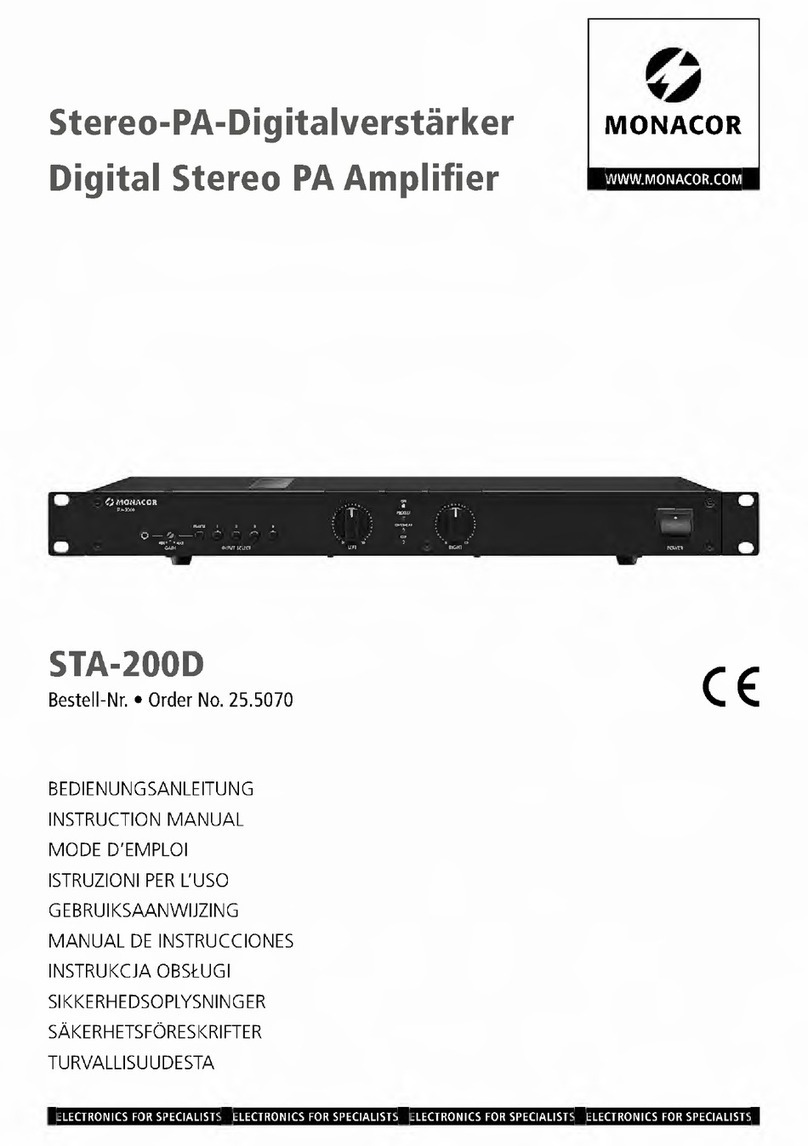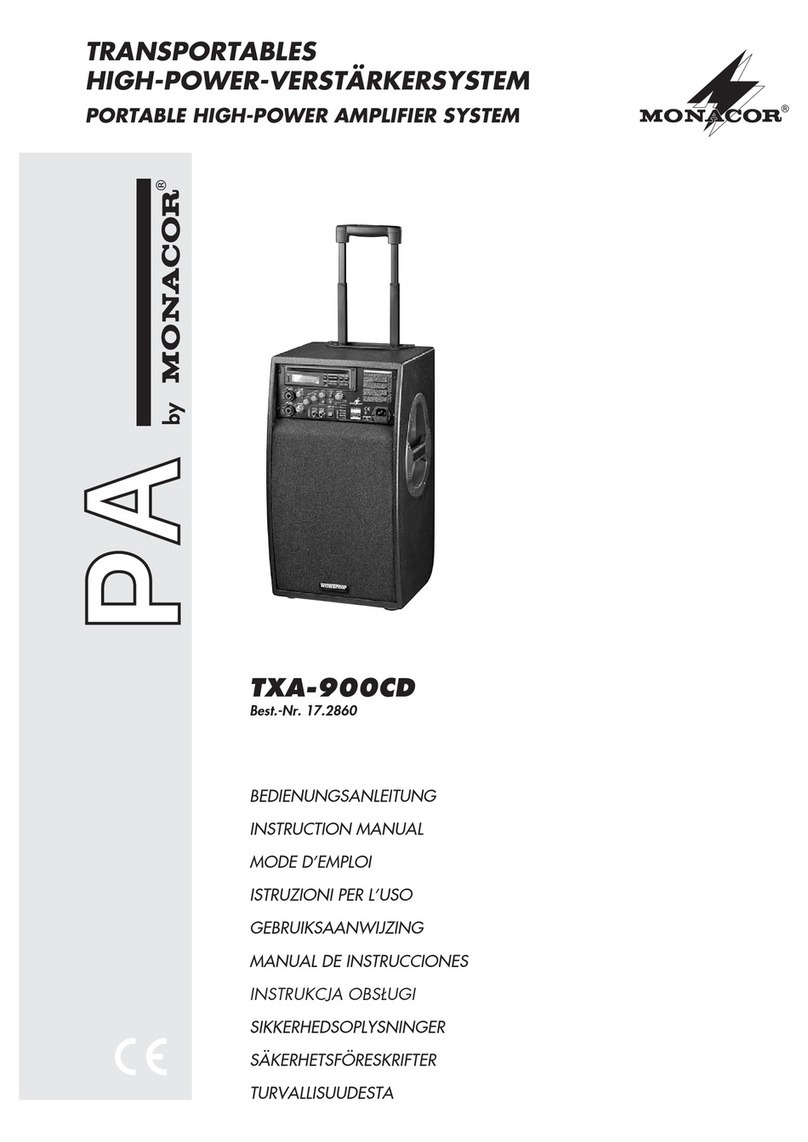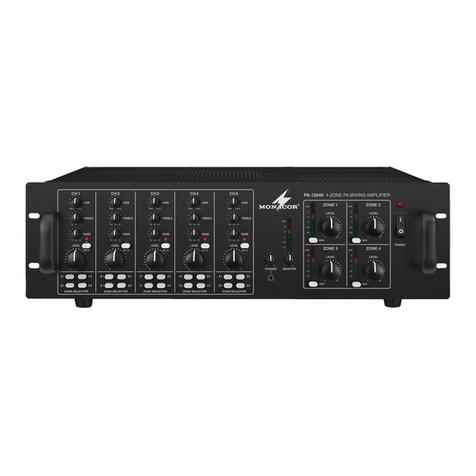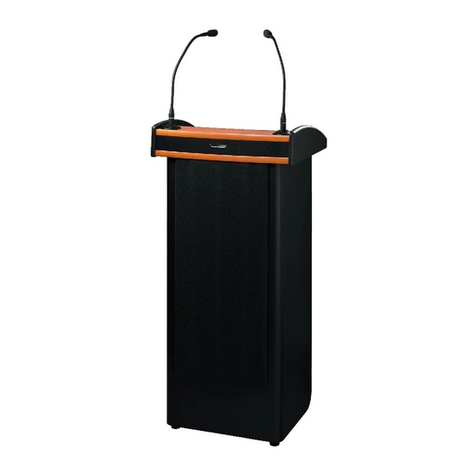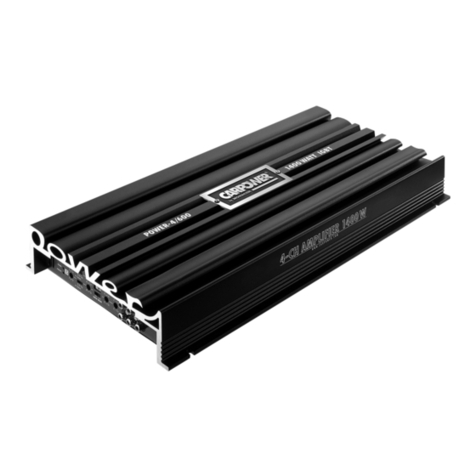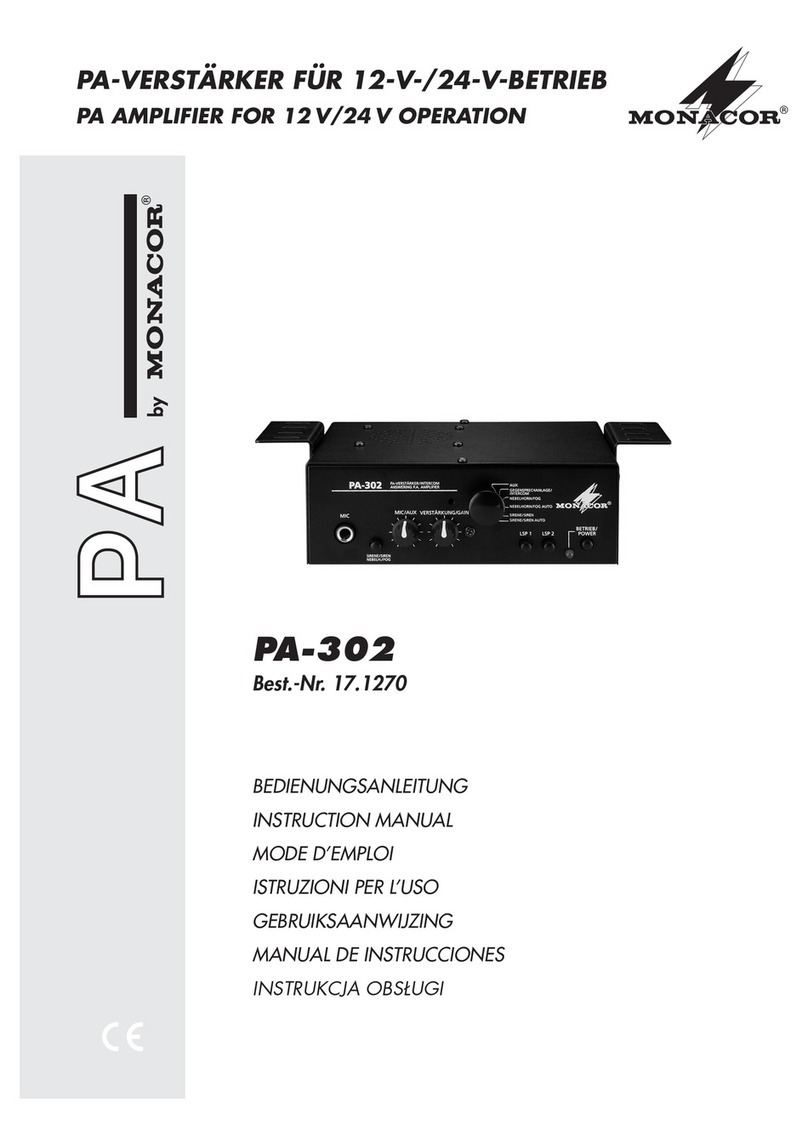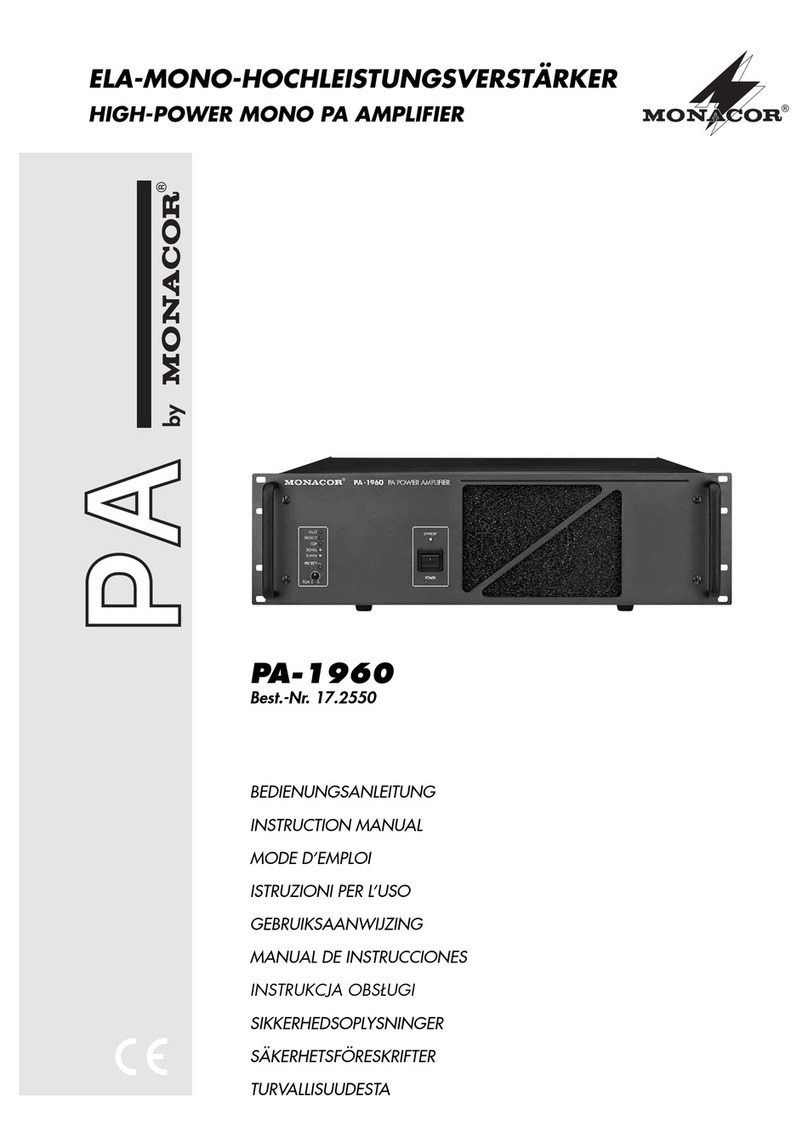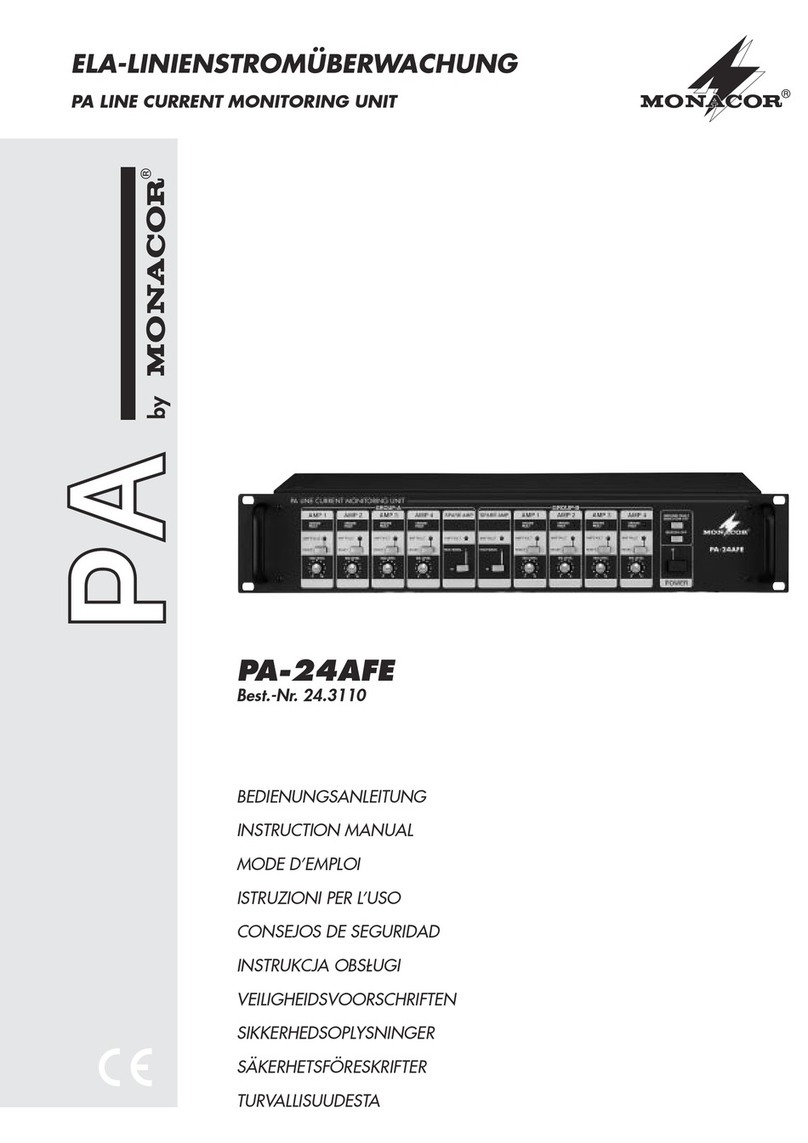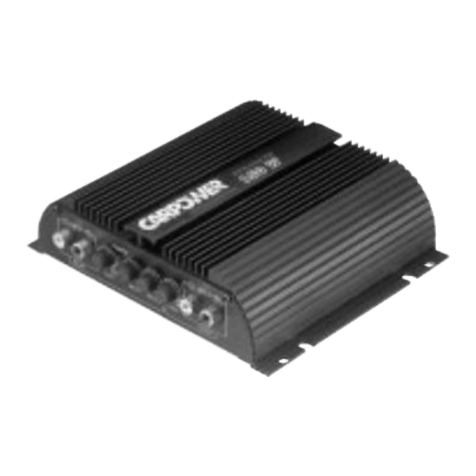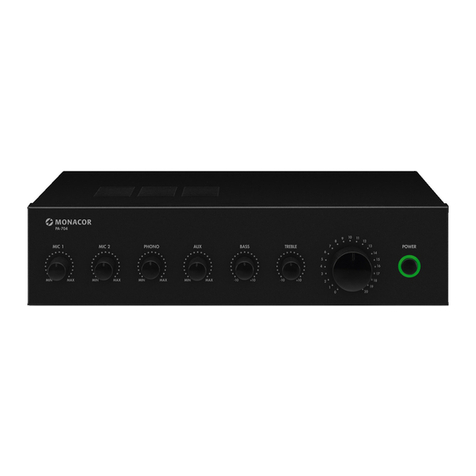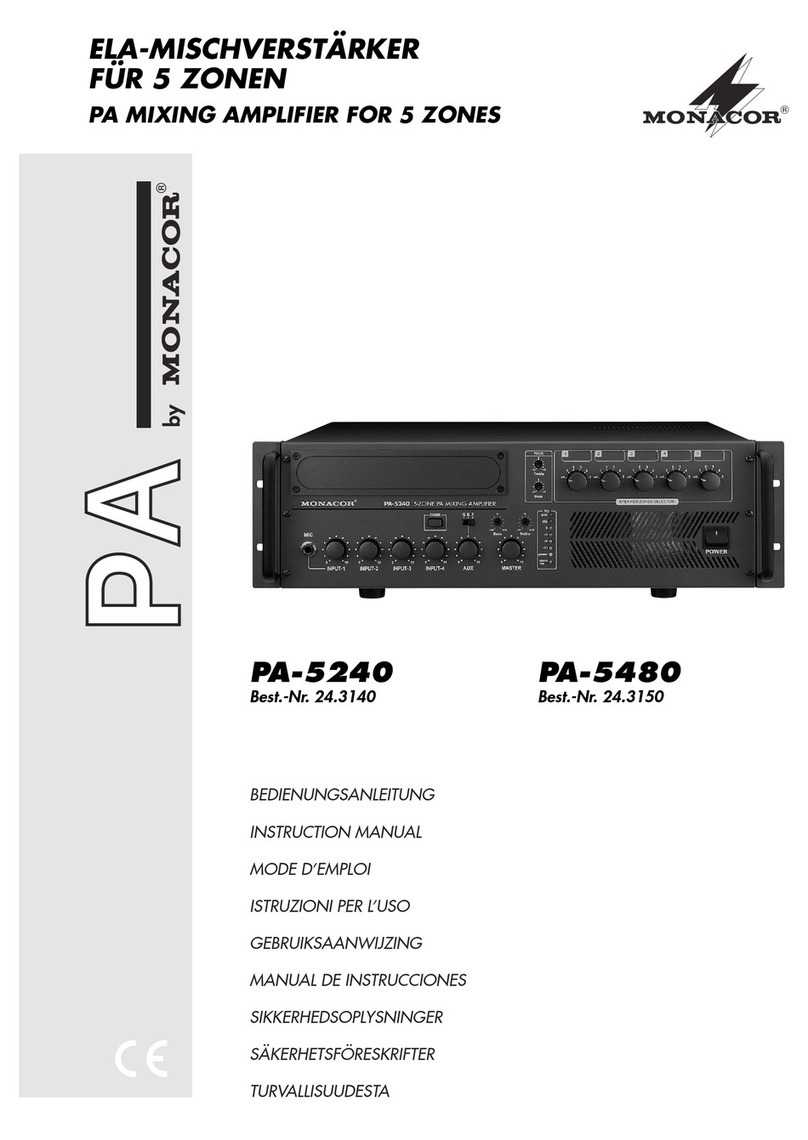HPR-6
Best.-Nr. 24.4210
wwwwww..iimmggssttaaggeelliinnee..ccoomm
Copyright©by MONACOR INTERNATIONAL GmbH & Co. KG, Bremen, Germany. All rights reserved. A-0344.99.02.09.2009
®
Amplificatore per cuffia stereo
1 Possibilità dʼimpiego
LʼHPR-6 amplifica il segnale dʼuscita Line di un appa-
recchio audio (p. es. di un lettore CD) per la riproduzione
con una cuffia o con degli altoparlanti piccoli.
2 Avvertenze di sicurezza
Gli apparecchi (amplificatore per cuffia e alimentatore
rete) sono conformi a tutte le direttive richieste dellʼUE
e pertanto portano la sigla .
GFar funzionare gli apparecchi solo allʼinterno di locali.
Proteggerli dallʼacqua gocciolante e dagli spruzzi
dʼacqua, da alta umidità dellʼaria e dal calore (tempe-
ratura dʼimpiego ammessa fra 0 e 40 °C).
GPer la pulizia usare solo un panno morbido, asciutto;
non impiegare in nessun caso prodotti chimici o
acqua.
GNel caso dʼuso improprio, di collegamenti sbagliati, di
ATTENZIONE! Lʼalimentatore rete funziona con peri-
colosa tensione di rete. Non intervenire mai al suo
interno; la manipolazione scorretta può provocare
delle scariche pericolose.
impiego scorretto o di riparazione non a regola dʼarte
degli apparecchi, non si assume nessuna responsa-
bilità per eventuali danni consequenziali a persone o
a cose e non si assume nessuna garanzia per gli
apparecchi.
3 Messa in funzione
1) Collegare lʼuscita Line dellʼapparecchio audio (p. es.
lettore CD, tape-deck, mixer) con le due prese RCA
INPUT (5).
2) Collegare la cuffia con la presa jack 6,3 mm OUT-
PUT (1). In alternativa, per mezzo di un jack stereo,
si possono collegare anche due altoparlanti piccoli
per il canale di sinistra e quello di destra.
3) Inserire la spina per alimentazione DC dellʼalimenta-
tore nella presa “12 V ” (2) ed inserire lʼalimenta-
tore in una presa di rete (100 – 240 V~/50 – 60 Hz).
Lʼamplificatore è ora pronto per funzionare.
Se si desidera eliminare gli apparecchi defi-
nitivamente, consegnarli per lo smaltimento
ad unʼistituzione locale per il riciclaggio.
4) Con il regolatore VOLUME (4) è possibile impostare
il volume e con il regolatore BALANCE (3) si regola
il bilanciamento.
5) Dopo lʼuso staccare lʼalimentatore dalla presa di rete
per non consumare inutilmente della corrente.
4 Dati tecnici
Sensibilità allʼingresso: . . . . 0,1–4V
Potenza dʼuscita per canale
con 4 Ω: . . . . . . . . . . . . . 525 mWRMS, 1,5 WMAX
con 8 Ω: . . . . . . . . . . . . . 330 mWRMS, 0,75 WMAX
con 32 Ω: . . . . . . . . . . . . 114 mWRMS, 0,2 WMAX
Gamma di frequenze: . . . . . 19 – 40 000 Hz
Rapporto S/R: . . . . . . . . . . . 69 dB
Fattore di distorsione: . . . . . 0,1 %
Alimentazione: . . . . . . . . . . 12 V /100 mA tramite
alimentatore in dotazione
Con riserva di modifiche tecniche.
ATTENZIONE! Mai tenere molto alto il volume delle
cuffie. A lungo andare, il volume eccessivo può pro-
curare danni allʼudito! Lʼorecchio si abitua agli alti
volumi e dopo un certo tempo non se ne rende più
conto. Non aumentare il volume successivamente.
Amplificador auricular estéreo
1 Posibilidades de utilización
El HPR-6 amplifica la señal de salida línea de un apa-
rato audio (por ejemplo lector CD) para la restitución vía
un auricular o altavoces pequeños.
2 Consejos de seguridad y de utilización
Los aparatos (amplificador auricular y alimentador)
cumplen con todas las directivas requeridas por la UE y
por lo tanto están marcados con el símbolo .
GLos aparatos están fabricados únicamente para una
utilización en interior. Protéjalos de salpicaduras, de
todo tipo de proyecciones de agua, de una humedad
elevada y del calor (temperatura ambiente admisible
0 – 40 °C).
GPara la limpieza, utilice un trapo seco y suave, no uti-
lice en ningún caso productos químicos o agua.
GDeclinamos toda responsabilidad en caso de daños
¡ATENCIÓN! El alimentador está alimentado por una
tensión peligrosa. No manipule nunca el interior del
aparato, en caso de manipulación inadecuada, podría
sufrir una descarga eléctrica mortal.
corporales o materiales resultandos si los aparatos
se utilizan para un fin diferente para el cual han sido
fabricados, si no están correctamente conectados,
utilizados o reparados por una persona habilitada;
además por todos estos mismos motivos los apara-
tos carecerían de todo tipo de garantía.
3 Funcionamiento
1) Conecte la salida línea del aparato audio (por ejem-
plo lector CD, tape deck, mesa de mezcla) a las dos
entradas RCA INPUT (5).
2) Conecte el auricular a la toma jack 6,35 OUTPUT (1).
También, puede conectar dos pequeños altavoces
para el canal izquierdo y el canal derecho vía una
toma jack 6,35 estéreo.
3) Ponga la toma baja tensión del alimentador en la
toma “12 V ” (2) y conecte el alimentador a un
enchufe de 100 – 240 V~/50 – 60 Hz. El amplificador
está entonces listo para funcionar.
4) Con el potenciómetro VOLUME (4), regule el volumen
y con el potenciómetro BALANCE (3), el balance.
Cuando los aparatos están definitivamente
sacados del servicio, deposite los aparatos
en una fábrica de reciclaje de proximidad para
contribuir a una eliminación no contaminante.
5) Después del funcionamiento, desconecte el alimen-
tador de la red de manera a no consumir corriente
inútilmente.
4 Características técnicas
Sensibilidad de entrada: . 0,1–4V
Potencia de salida por canal
Bajo 4 Ω: . . . . . . . . . . . 525 mWRMS, 1,5 WMAX
Bajo 8 Ω: . . . . . . . . . . . 330 mWRMS, 0,75 WMAX
Bajo 32 Ω: . . . . . . . . . . 114 mWRMS, 0,2 WMAX
Banda pasante: . . . . . . . . 19 – 40 000 Hz
Relación señal/ruido: . . . . 69 dB
Tasa de distorsión: . . . . . . 0,1 %
Alimentación: . . . . . . . . . . 12 V /100 mA por
alimentador entregado
Nos reservamos el derecho de modificación sin previo aviso.
¡ATENCIÓN! No regule el volumen del auricular
demasiado fuerte. Un volumen demasiado elevado,
puede a lo largo del tiempo, provocar problemas de
audición. La oreja humana se acostumbra a volú-
menes elevados y acaba por no percibirlos como
tales al cabo de un tiempo. Le aconsejamos enton-
ces de regular el volumen y de no modificarlo más.
Stereofoniczny wzmacniacz
słuchawkowy
1 Zastosowanie
HPR-6 jest stereofonicznym wzmacniaczem słuchaw-
kowym. Wzmacnia sygnał z wyjścia liniowego urządze-
nia audio (np. odtwarzacz CD) do poziomu odpowied-
niego dla słuchawek lub małych zestawów
głośnikowych.
2 Środki ostrożności
Urządzenia (wzmacniacz oraz zasilacz) spełniają
wymagania norm UE, dlatego zostały oznaczone sym-
bolem .
GUrządzenie jest przeznaczone tylko do użytku
wewnątrz pomieszczeń. Należy chronić przed dosta-
niem się jakiejkolwiek cieczy do środka urządzenia,
dużą wilgotnością oraz ciepłem (temperatura otocze-
nia powinna wynosić od 0 – 40 °C).
UWAGA! Zasilacz jest zasilany niebezpiecznym dla
życia napięciem zmiennym. Aby uniknąć porażenia
elektrycznego nie wolno otwierać urządzenia. Jego
naprawą powinien zajmować się tylko przeszkolony
personel.
GDo czyszczenie należy używać wyłącznie suchej,
miękkiej ściereczki. Nie wolno używać wody ani żad-
nych środków chemicznych.
GNie ponosi się odpowiedzialności za wynikłe uszko-
dzenia sprzętu lub obrażenia użytkownika w przy-
padku, gdy urządzenia są wykorzystywane w innych
celach niż to się przewiduje lub, jeśli są nieodpo-
wiednio zainstalowane, użytkowane lub naprawiane.
3 Obsługa
1) Podłączyć wyjście liniowe urządzenia audio (np. odt-
warzacz CD, magnetofon, mikser) do gniazd chinch
INPUT (5).
2) Do gniazda wyjściowego typu duży jack 6,3 mm
OUTPUT (1) podłączyć słuchawki. Alternatywnie do
tego gniazda można podłączyć także małe zestawy
głośnikowe.
3) Podłączyć wtyk zasilacza do gniazda “12 V ” (2), a
następnie wtyczkę sieciową zasilacza do gniazda
sieciowego (100 – 240 V~/50 – 60 Hz). Wzmacniacz
jest gotowy do pracy.
Aby nie zaśmiecać środowiska po całko-
witym zakończeniu eksploatacji urządzeń
należy je oddać do punktu recyklingu.
4) Ustawić głośność za pomocą regulatora VOLUME
(4) oraz balans za pomocą regulatora BALANCE (3).
5) Po zakończeniu pracy, odłączyć zasilacz z sieci, aby
nie pobierał on niepotrzebnie energii.
4 Dane techniczne
Czułość wejściowa: . . . . 0,1V–4V
Moc wyjściowa na kanał
przy 4 Ω: . . . . . . . . . . 525 mWRMS, 1,5 WMAX
przy 8 Ω: . . . . . . . . . . 330 mWRMS, 0,75 WMAX
przy 32 Ω: . . . . . . . . . 114 mWRMS, 0,2 WMAX
Pasmo przenoszenia: . . . 19 – 40 000 Hz
Stosunek S/N: . . . . . . . . 69 dB
THD: . . . . . . . . . . . . . . . . 0,1 %
Zasilanie: . . . . . . . . . . . .
12 V /100 mA z zasilacza
podłączonego do sieci
Z zastrzeżeniem do możliwych zmian.
UWAGA! Nigdy nie ustawiać bardzo dużej głoś-
ności! Stały, bardzo wysoki poziom dźwięku może
uszkodzić narząd słuchu. Ucho ludzkie adaptuje
się do dużych głośności, które po pewnym czasie
nie są już percepowane jako wysokie. Dlatego też,
nie wolno przekraczać raz już ustawionego maksy-
malnego poziomu głośności.



